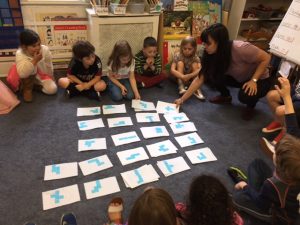Procedural and computational fluency is achieved by building on a foundation of conceptual understanding. Fluency is not attained by simply memorizing facts, or following mechanical step by step procedures. The first step towards fluency is building number sense through problem solving. In the process of solving a problem, students engage in exploration and discussion, while discoveries of the properties of operations emerge into strategies and tools they apply and put to use. These informal approaches are refined and built upon, and eventually become tested and efficient methods that students can rely on. Students remain flexible in their choice of strategies, basing their decisions on understanding, efficiency, and accuracy.
Making Sense of Problems by Seeing How They are Structured.
Kindergartners Use Dramatic Play to Model the Structure of Addition and Subtraction Problems.
Kindergartners related math stories to birds, their current social studies and science topic, by using dramatic play to act out addition and subtraction problems. Through these stories, students explored the action in different structures of problems (see chart below). Some examples of addition structure bird stories that students acted out were result unknown, change unknown, and both addends unknown. “Students who are taught to approach problems by looking at their structures through the use of a visual model are more likely to perform better than students who do not” (NCTM, 2014, pg. 50). This approach helps students make better sense of the action that is happening in problems and rely less on using keywords that can often be interpreted in many different ways (Karp, 2014, pg. 21).
An Example of Student Work Showing Change Unknown Structure Along With a Structure Diagram:
“Six pigeons were pecking on the sidewalk on Bleecker Street. Some more pigeons came to see what they were pecking at. Then there were ten pigeons.” (CHANGE UNKNOWN/ADD TO).
Addition/Subtraction Problem Structures:
2014 Karp, Karen S., Teaching Children Mathematics. National Council of Teachers of Mathematics
2014 NCTM. Putting Essential Understanding of Addition and Subtraction into Practice
















